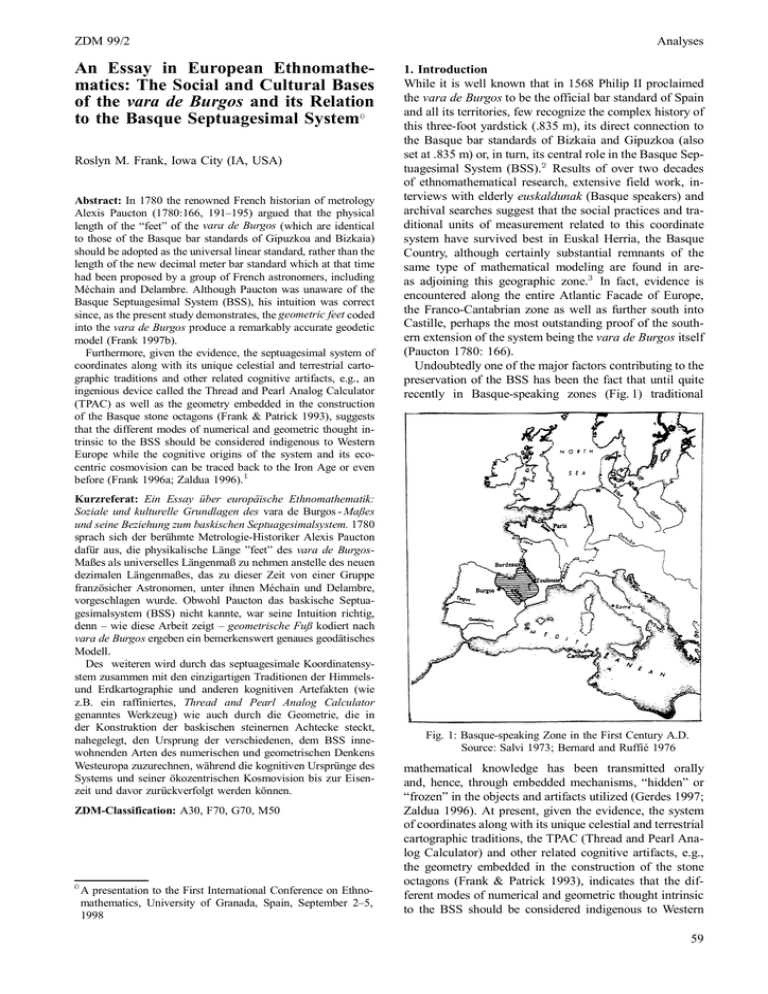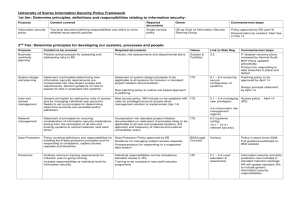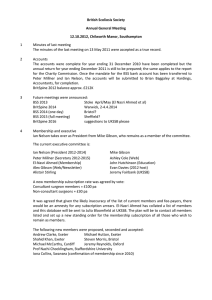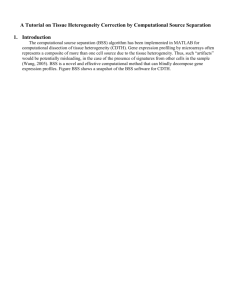An Essay in European Ethnomathe- matics: The Social and Cultural Bases
advertisement

ZDM 99/2 An Essay in European Ethnomathematics: The Social and Cultural Bases of the vara de Burgos and its Relation to the Basque Septuagesimal System Roslyn M. Frank, Iowa City (IA, USA) Abstract: In 1780 the renowned French historian of metrology Alexis Paucton (1780:166, 191–195) argued that the physical length of the “feet” of the vara de Burgos (which are identical to those of the Basque bar standards of Gipuzkoa and Bizkaia) should be adopted as the universal linear standard, rather than the length of the new decimal meter bar standard which at that time had been proposed by a group of French astronomers, including Méchain and Delambre. Although Paucton was unaware of the Basque Septuagesimal System (BSS), his intuition was correct since, as the present study demonstrates, the geometric feet coded into the vara de Burgos produce a remarkably accurate geodetic model (Frank 1997b). Furthermore, given the evidence, the septuagesimal system of coordinates along with its unique celestial and terrestrial cartographic traditions and other related cognitive artifacts, e.g., an ingenious device called the Thread and Pearl Analog Calculator (TPAC) as well as the geometry embedded in the construction of the Basque stone octagons (Frank & Patrick 1993), suggests that the different modes of numerical and geometric thought intrinsic to the BSS should be considered indigenous to Western Europe while the cognitive origins of the system and its ecocentric cosmovision can be traced back to the Iron Age or even before (Frank 1996a; Zaldua 1996). Kurzreferat: Ein Essay über europäische Ethnomathematik: Soziale und kulturelle Grundlagen des vara de Burgos - Maßes und seine Beziehung zum baskischen Septuagesimalsystem. 1780 sprach sich der berühmte Metrologie-Historiker Alexis Paucton dafür aus, die physikalische Länge ”feet” des vara de BurgosMaßes als universelles Längenmaß zu nehmen anstelle des neuen dezimalen Längenmaßes, das zu dieser Zeit von einer Gruppe französicher Astronomen, unter ihnen Méchain und Delambre, vorgeschlagen wurde. Obwohl Paucton das baskische Septuagesimalsystem (BSS) nicht kannte, war seine Intuition richtig, denn – wie diese Arbeit zeigt – geometrische Fuß kodiert nach vara de Burgos ergeben ein bemerkenswert genaues geodätisches Modell. Des weiteren wird durch das septuagesimale Koordinatensystem zusammen mit den einzigartigen Traditionen der Himmelsund Erdkartographie und anderen kognitiven Artefakten (wie z.B. ein raffiniertes, Thread and Pearl Analog Calculator genanntes Werkzeug) wie auch durch die Geometrie, die in der Konstruktion der baskischen steinernen Achtecke steckt, nahegelegt, den Ursprung der verschiedenen, dem BSS innewohnenden Arten des numerischen und geometrischen Denkens Westeuropa zuzurechnen, während die kognitiven Ursprünge des Systems und seiner ökozentrischen Kosmovision bis zur Eisenzeit und davor zurückverfolgt werden können. ZDM-Classification: A30, F70, G70, M50 A presentation to the First International Conference on Ethno- mathematics, University of Granada, Spain, September 2–5, 1998 Analyses 1. Introduction While it is well known that in 1568 Philip II proclaimed the vara de Burgos to be the official bar standard of Spain and all its territories, few recognize the complex history of this three-foot yardstick (.835 m), its direct connection to the Basque bar standards of Bizkaia and Gipuzkoa (also set at .835 m) or, in turn, its central role in the Basque Septuagesimal System (BSS). Results of over two decades of ethnomathematical research, extensive field work, interviews with elderly euskaldunak (Basque speakers) and archival searches suggest that the social practices and traditional units of measurement related to this coordinate system have survived best in Euskal Herria, the Basque Country, although certainly substantial remnants of the same type of mathematical modeling are found in areas adjoining this geographic zone. In fact, evidence is encountered along the entire Atlantic Facade of Europe, the Franco-Cantabrian zone as well as further south into Castille, perhaps the most outstanding proof of the southern extension of the system being the vara de Burgos itself (Paucton 1780: 166). Undoubtedly one of the major factors contributing to the preservation of the BSS has been the fact that until quite recently in Basque-speaking zones (Fig. 1) traditional Fig. 1: Basque-speaking Zone in the First Century A.D. Source: Salvi 1973; Bernard and Ruffié 1976 mathematical knowledge has been transmitted orally and, hence, through embedded mechanisms, “hidden” or “frozen” in the objects and artifacts utilized (Gerdes 1997; Zaldua 1996). At present, given the evidence, the system of coordinates along with its unique celestial and terrestrial cartographic traditions, the TPAC (Thread and Pearl Analog Calculator) and other related cognitive artifacts, e.g., the geometry embedded in the construction of the stone octagons (Frank & Patrick 1993), indicates that the different modes of numerical and geometric thought intrinsic to the BSS should be considered indigenous to Western 59 Analyses Europe while the cognitive origins of the system itself can be traced back to the Iron Age or even before (Frank 1996a; Zaldua 1996). Moreover, an examination of the coordinate system’s social and cultural bases, the septarian and septuagesimal units of measurement utilized, the polar perspective of its TPAC, as well as the ecocentric cosmovision to which it was (and is) intimately linked, suggests that its geographical extension was far more wide-spread than it might appear today: that earlier the orally transmitted cultural products, numerical and geometric modes of thought, associated with the system were actively present in much of Western Europe. In short, there is reason to believe that the ecocentric cosmovision inherent to the BSS as well as the mathematics “frozen” in its associated artifacts, are representative of a much earlier indigenous pan-European cognitive framework (cf. Frank 1996b, 1996c, 1996d, 1997a). In the sections that follow I shall summarize ever so briefly the results derived from the first stages of this process of “unthawing” these “frozen” mathematical traditions. Hopefully, the present study will help mathematics educators begin to recognize the cultural, educational and scientific value of rediscovering and further exploring the BSS, perhaps the most extensive sample of what appears to be a recoverable indigenous European (ethno)mathematical tradition, and incorporating it into the curriculum alongside the African and AmericanIndian traditions that, until recently, have been ignored by the majority of mathematics educators. 2. Overview of the BSS mathematical model With respect to the cognitive frames of the BSS, one discovers that it is the interaction of the human body with the environment that provides the basis for the system and its remarkable ability to model space and time. Concretely it is the distance traveled, walking, in one hour that forms the conceptual grounding for a timefactored unit of linear measurement: the septarian league. In the BSS, the latter distance is quantified as 3 3/7 thousand geometric strides, each of five geometric feet with each foot calculated at 1/3 of the vara de Burgos (3 3/7 thousand d 17,142 6/7 g. ft Furthermore, in the BSS model, that is, in this mathematical simulation, r of meridional arc is set at 400,000 g. ft. Hence, the coordinate system assigns a value of 23 1/3 g. leagues to r of arc (400,000 17,142 6/7 23 1/3). In practice, the g. league was divided into thirds, each of 1 1/7 thousand g. strides. This unit is referred to as a geometric mile. At this point we can summarize the relationships holding between the different units of measurement which were manipulated in the BSS mathematical idealization. 360r = 8400 leagues = 25,200 g. miles = 144 million g. ft. 1r = 23 1/3 g. leagues = 70 g. miles = 400,000 g. ft. 3/70 of 1r = 1 g. league = 3 g. miles = 17,142 6/7 g. ft. 1/70 of 1r = 1 g. mile = 5,714 2/7 g. ft. Table 1: Summary of the septuagesimal unit types In addition, the manipulation of the aforementioned device, the TPAC, allows for the graphic or manual calcula60 ZDM 99/2 tion the length of r of arc at any latitude without recourse to the formulas of plane trigonometry nor, more specifically, the prior calculation of the cosine of the angle of the latitude in question (Frank 1997b, 1997c). Most interesting is the fact that cartographic traditions associated with the aforementioned device, the TPAC, set up the celestial coordinates in such a way that already by the early Middle Ages it can be recognized that the parallel of r N. had come to be utilized in the standard scale of portolans and maps, a scale that assigned to r at that latitude, namely at r , 17.5 g. leagues, i.e., 300,000 g. ft. The parallel in question passes just north of Madrid, Spain, extends across the Mediterranean slightly south of Rome and then eastward through Thessaloniki, Greece. Over time traditional knowledge related to the functioning of the BSS was lost or misplaced among the emerging mathematical traditions characteristic of a numerically literate culture. One proof of such a loss of knowledge can be documented already in the early Renaissance in the instance of cartographers operating exclusively through recourse to computational approaches which had been transmitted to them through literate rather than oral channels. Over time, the scale in question, that of 17.5 g. leagues which was valid for navigating in the Mediterranean, came to be read by cartographers, mistakenly, as if it corresponded to r of equatorial arc, reducing in turn the size of the sphere being modeled (cf. García Franco 1956: 53– 58). For the most part by the early Renaissance knowledge of the strategies needed to manipulate the BSS units of measurement and the overall functioning of the septuagesimal coordinate system to which the septarian league belongs, appears to have become fragmented, particularly among the literate mathematical elite, although oral transmissions of the system seem to have continued sporadically among the numerically illiterate popular classes. In fact, the traditional non-computational approach intrinsic to the TPAC which was utilized by numerically illiterate ship’s pilots was eventually lost and replaced by trigonometric computational cartographic traditions, the latter informed almost exclusively by decimality and preference for the dominant sexagesimal systems. Nonetheless, two Basque writers, Andrés de Poza (1585) and Antonio Gaztañeta Iturribalzaga (1692) continued to insist on the correctness of the septarian league, although it would appear that these two authors had only a limited knowledge of the overall functioning of the septuagesimal system itself (García Franco 1957: 50–58). In fact, there is reason to believe that because of the oral nature of the coordinate system in question, its informal mechanisms of transmission led to it becoming “frozen” or perhaps better stated, “preserved” in a series of social practices and artifacts, such as the TPAC. And, perhaps precisely because of its oral nature, the BSS has survived alongside what, from the point of view of ethnomathematics, is a truly remarkable artifact, the vara de Burgos itself, a representative of earlier bar standards which through techniques of celestial observation still not fully understood today, stored a surprisingly accurate version of the European geometric foot whose conceptual length ZDM 99/2 was 1/400,000 of r of meridional arc (Paucton 1780: 166, 194). In order to appreciate what occurred when the BSS coordinates were replaced by those of the decimal metric system and, consequently, the reasons for the apparent accuracy of the length of the feet coded into the vara de Burgos, we need to compare the geometric feet of this preexisting vara standard with those that can be derived mathematically from modern calibrations of the physical length of the Earth’s quadrant. For example, in the eighteenthcentury, we encounter astronomers engaged in surveying operations intended to calibrate the physical length of the new decimal metric bar standard. The latter was conceptualized by means of a decimal model as one ten-millionth of the Earth’s quadrant (Good 1998: 267–270). In the context of this study the latter mathematical abstraction, the decimal metric system, will be referenced as DMS. At this stage we discover that, in reality, we are speaking of two mathematical abstractions of the same entity: two approaches to mathematically modelling a sphere. As a consequence, first we must understand that given the definitional value of the units from each system of coordinates, that is, from each mathematical abstraction, the ratio holding between them is 10/36 or .278: the DMS divides the quadrant into 10 million parts, while the BSS divides it into 36 million (400,000d). Second, the ratio, in and of itself, is merely a mathematical abstraction. It has no extension. It has no intrinsic physical length associated with it until the mathematical abstraction in question is applied to a concrete object. Third, in practice, the preexisting geometric foot from the BSS model does have extensions: it is embodied in much earlier bar standards whose physical dimensions can be determined, e.g., the vara de Burgos. Although without a clear understanding of the functioning of the BSS celestial and terrestrial coordinates, Paucton (1780: 166–169) argued that the level of accuracy of the feet found in the vara de Burgos was such that they should be utilized to read just the existing standards of the foot in other parts of Europe to a single universal standard, rather than introducing a new decimal metric one. García Franco (1957: 62) also notes that the earlier metrological standard, the geometric foot, would have had a value of .278 when translated into the new decimal metric mathematical idealization of the sphere in which the quadrant was divided into ten million parts: 10/36 = .278. For the sake of comparison we note that when the physical length of the decimal meter bar standard was established, the feet of the vara de Burgos were assigned a value in meters of .2784. In summary, in the much earlier European system, each geometric foot, as has been stated, was set at 1/400,000 of r of meridional arc, a mathematical idealization which produced a quadrant set at 36 million g. ft. It was this system of coordinates that at the end of the eighteenth-century was finally replaced by the DMS and the decimal metric bar standard. 3. The pre-decimal metric septarian bar standard Moreover, we can argue that the decimal metric model itself was based directly upon a unit of measurement found Analyses in the earlier BSS mathematical idealization. In order to bring this aspect of the data into clearer focus we need to examine the unit in question, one that manipulates geometric feet in units of seven. In Euskera the seven-foot unit is called a gizabete. In Spain the same seven-foot unit goes under the names of estado, brazada, braza, estado and toesa, while in France the unit is called a toise (Carrion Arregui 1996; Martínez Gómez [1795] 1816; Zupko 1978: 175–176). Indeed, the toise was the official pre-decimal metric standard of France. By the middle of the eighteenth-century it functioned as the “linear measure most commonly used by the royal armies and navies as well as in mathematical works in Spain, Italy, and a large part of the rest of Europe” (García Franco 1957: 76). Given its widespread usage, we may state that in practice the toise functioned as the pre-decimal metric standard for most of Europe. Hence, in the eighteenthcentury when astronomers from various nations undertook surveys to determine the length of r of meridional arc at different latitudes, their astronomical calculations were carried out using the toise, concretely, using replicas of an iron bar standard called the toise du Châtelet housed in Paris (Bigourdan 1901; Paucton 1780: 17–18; Strasser 1975). But there is a catch. In France at the time that these astronomical observations and surveys were carried out, the toise was defined officially as six pieds de roi. These royal feet are sometimes referred to as pieds de Paris. Yet to the south of Paris the equivalency between the Castillian and French standards was well known (García Franco 1957: 72–76; Paucton 1780: 750). For example, the Basque surveyor and engineer Villarreal de Berriz explains that “seven common feet of Castille” are precisely equal to “six royal feet of Paris” (Villarreal de Berriz [1763] 1973: 116–117). Moreover, in 1752, Jorge Juan, the Spanish astronomer who measured r of equatorial arc of the meridian in Peru, repeats the same equivalency in his report on that expedition (García Franco, 1957: 82). Hence, in fact, the DMS calculations were undertaken utilizing a standard septarian unit from the BSS. At this stage we can compare the BSS mathematical idealization to the actual results obtained by astronomers who working under the auspices of the French Academy of Sciences were attempting to determine the length of r of meridian arc at different latitudes. Their results eventually confirmed the earlier theoretical studies of Newton and his contemporary Huygens that the rotating Earth was an oblate spheroid, flattened at the poles. Thus, on such an ellipsoid the length of a meridian degree varies, increasing in length with the latitude: it is longer at the pole than at lower latitudes and the equator. However, before examining these results, there is a caveat that must be expressed. When speaking of the actual physical length of these standards, it is obvious that in centuries past, for example, in the Middle Ages, there were definitely upper limits to the level of accuracy that could have been achieved when smelting a metal bar standard. In addition, there is another practical aspect to the problems involved in attempting to introduce such high levels of precision into an iron bar standard: when sur61 Analyses ZDM 99/2 veying in the field, changes in temperature produce slight alterations in the bar’s length (cf. Strasser 1975). Moreover, Paucton himself points out that the length of the official toise du Châtelet bar standard was slightly shortened in 1668 (Paucton 1780: 17–18). Also, Strasser (1975) and Zupko (1990: 114–115) list additional problems that arose in efforts made in the eighteenth and nineteenthcenturies to mill highly accurate DMS bar standards, each with precisely the same length. Hence, we recognize that any attempt to argue for such extraordinarily high levels of accuracy in the earlier geometric foot is both wrongheaded and futile. Rather we need to recognize that we are talking about two different mathematical abstractions, two coordinate systems, and the problems involved when translating the value of units from one to the other. In other words, in the 1790’s, when the length of the toise standard was being translated, that is, converted into meters, the value assigned to it in meters depended on the number of toise assigned to the average length of a meridian degree. The meter did not yet exist. This point is a subtle one. In the first mathematical abstraction, the BSS, the Earth’s quadrant was divided into 36 million parts, while in the second, the decimal metric model, the quadrant was divided into 10 million parts. Therefore, as has been stated, by mathematical necessity the prototypical length of the geometric foot when translated into the second model is equal to the fraction of 10/36 or .278. 4. Translation of BSS and DMS values When the observations carried out by Méchain and Delambre under the auspices of the French Academy of Sciences were finally accepted in 1798, the feet of the vara de Burgos were assigned a value of .2784 m and, thus, the value of the septarian toise unit was set at 1.949 m. The astronomers’ results argued for setting the value of r of meridian arc at 57,008.222 t. According to the standard division of the European foot, each inch was divided into 12 lines. Hence, there were 864 Paris Lines (144 d 6 = 864) in the toise of six pieds de roi. It was the latter figure that Méchain and Delambre utilized to define the toise and carry out their conversion: Meridian Quadrant: 57,008.222 t d 90 5,130,740 t d 864 = 443.296 d 10 5,130,740 t Given that the reciprocal of .513074 is 1.949, that figure defined the length assigned to the septarian unit while each foot was equal to .2784 of the new decimal metric bar standard (Méchain and Delambre 1810: 664–665; Berriman 1953: 143). Consequently, it is clear that Paucton, writing in 1780, was correct in his assumption that among the various values given to the foot in different parts of Europe, the feet of the vara de Burgos and the Basque bar standards most closely replicated the desired prototype. From our vantage point we can appreciate that by means of these operations Méchain and Delambre were also involved in determining the ratio of the BSS septarian bar standard when translated into the DMS model. Obviously at the time neither of them was aware of the implications of what they were doing. From the evidence they apparently knew nothing of the BSS coordinates. Hence, having no awareness of the BSS, as far 62 as the two astronomers were concerned when they set the value of r of meridian arc at 57,008.222 t, they were merely setting the quadrant at 5,130,740 t. This, in turn, set the ratio that would determine the length of the new DMS bar standard at 443.295936 Paris Lines of the previous BSS toise standard, a figure they later rounded off to 443.296 (Méchain and Delambre 1810: 664–665; Strasser 1975: 30). The precision of the ratio 443.295936 results from their setting the value of r of meridian arc at 57,008.222 t (5,130,740 t b 57,008.222 t. And the DMS definition of the length of the BSS septarian bar standard is merely the reciprocal of .513074: 10,000,000/5,130,740 t = 1.949036591 m. In short, Méchain and Delambre’s approach to the problem guaranteed that their figures would produce a DMS bar standard apparently set at one ten-millionth of the Earth’s quadrant: 5,130,740 t. d 1.949036591 9,999,999.998 m. 5. Recuperating the BSS mathematical model As has been repeatedly emphasized in the context of this study, the BSS and the DMS are mathematical models, abstractions without extension until they are applied to a concrete object. Hence, the value that was finally assigned in meters to the physical length of the feet of the vara de Burgos was a direct mathematical result of the conversion from the BSS model to the DMS model. This is because the preexisting bar standard which the astronomers themselves utilized to carry out their surveys was a bar standard from the earlier BSS model, concretely, the septarian toise unit. So, in reality, the scientists were converting units directly from one mathematical model to the other. The following interrelated examples will further aid in comprehending the intrinsic circularity of the data. For instance, if Méchain and Delambre were to have determined that r of meridian arc was equivalent to 57,052.33 t, the value of the quadrant would have been set at 5,134,709.7 t, the septarian unit at 1.94753 and the geometric foot at .27822 ( ): Meridian Quadrant: 57,052.33 t d 90 5,134,709.7 t 5,134,709.7 t d 864 443.63892 d 10 Such an estimate would have coincided closely with the modern assignment based on a mean radius calculated at 6,371.004 m (British Astronomical Association 1998). Remembering that the acceptance of Méchain and Delambre’s estimate set the ratio or value of the septarian bar standard at 1.949 m, we can determine that today’s assignment of 111,195 m to r of meridian arc translates as 57,052.33 t (111,195 1.949 57,052.33 t). Therefore, if a mathematical educator wants to retrieve the coordinates of the BSS as a classroom exercise, it can be done by setting BSS units of measurement so that they coincide precisely with twentieth-century estimates of the Earth’s mean radius. To do this the following operations would need to be carried out. Using a mean radius of 6,371.004 km, the model yields r of meridian arc defined at 111,195 m. This setting produces a ratio for the geometric foot of .2779875 (111,195 400,000 .2779875) and a ratio for the septarian bar standard of 1.9459125. Once the value of the geometric foot is made to coincide with the modern estimate of the Earth’s mean radius, ZDM 99/2 namely, by assigning it a value in meters of .2779875 m (or merely .278 m), this translation of the BSS units into their modern equivalents allows for the recuperation of the symmetry inherent in the earlier BSS mapping traditions for the modelling of the Earth. By assigning whole numbers, precisely 400,000 g. ft, to r of meridian arc, the quadrant is set at 36 million g. ft and the circumference at 144 million g. ft. For classroom purposes, the mathematics educator could point out to students the inherent mathematical symmetry of the BSS model. They would recognize that this model contrasts with the twentieth-century rendition of the DMS representation of the Earth in which r of meridian arc is defined as 111,195 m, the quadrant as 10,007,755 m and the circumference as 40,030,200 m. Additionally, keeping in mind that the BSS is a mathematical abstraction of a sphere (and not the oblate spheroid which is the Earth), it has other classroom applications. For instance, the retrieval of the BSS values would allow students to construct a TPAC and use it to explore other aspects of the TPAC itself, particularly its usefulness as a visually stimulating and, hence, explicit mechanism for exploring the geometry of any sphere, that is, when viewed from a polar perspective. 6. Conclusion In summary, we need to realize that there is an inevitable mathematical circularity built into the data we are discussing. When the BSS unit was converted into DMS units, that is, when the BSS septarian bar standard was translated into the DMS decimal metric bar standard, the value assigned to the former was dependent on the determination of the physical length of the Earth’s quadrant. We need to remember that the determination in question was calibrated in units from the older BSS septarian bar standard. Stated differently, the assignment of the ratio of .2784, the value assigned to the feet of the vara de Burgos, was directly dependent on the late eighteenth-century DMS definition of the physical length of the quadrant, namely, on the acceptance of the results presented by Méchain and Delambre to French Academy Sciences in 1798 (Méchain and Delambre 1810: 664–665; Berriman 1953: 140–144). We may conclude that the DMS model was itself based on a preexisting, cognitively astute mathematical idealization, the BSS, whose coordinates and units of measurement have gone relatively unnoticed by historians of science. Furthermore, we note that the densest networks of data relating to the units of measurement belonging to the BSS coordinate system have survived in Euskal Herria where they have been transmitted orally from one generation to the next. This suggests that the different cognitive modes of numerical and geometric thought embedded in the BSS hearken back to a much earlier European cognitive framework. Finally, throughout the course of this study the ecocentric nature of the model has been highlighted. Since to fully explain the concept contained in the term ecocentric would require a separate treatment, for the moment let it suffice to say the following: that the cosmovision linked to the BSS is one in which the human body embodies Analyses and interacts with its environment. Far from emphasizing some sort of desire for transcendence, the BSS cosmovision demonstrates an active concern on the part of its intellectual authors with their immediate environment. Concretely, the BSS reflects the preoccupations of its inventors whose curiosity and perseverance led them to explore and structure the terrestrial and celestial coordinates of their surroundings as they did. In this sense they ended up creating a model that virtually allowed them to inhabit their environment. By actively setting about to structure their environment, the here and now, they achieved a result that permitted the human body itself to interact with time and space, specifically, by means of the time-factored septarian quantification of the league. In this sense the human body was incorporated into the system, into the larger symmetry produced by the BSS model. In essence, the human body became the measure of all things. In turn, we may argue that the cosmovision in question suggests a concern with constructing a model that itself would embody a perception of symmetry and balance: an innate ordering of the cosmos. For this reason, although certainly there is an anthropocentric element present in the BSS, namely, the incorporation of structures inherent in the anatomy of humans, that element is inserted into and interacts with the larger scheme of things. Thus, because of this basic interactive aspect, we may assert that the system is fundamentally ecocentric in nature (cf. Snyder 1995: 67–73; Oelschlaeger, 1991: 281–308). Hopefully the present study will serve as a first step in recuperating these ecocentric mathematical traditions and will afford us a vantage point from which to appreciate the unquestionable complexity and sophistication of these modes of thought as well as to explore them further. 7. Notes This project has been supported by the Institute of Basque Studies, 99 Tufnell Park Road, London N7 OPS, UK, a nonprofit research trust dedicated to the promotion and dissemination of investigations related to Euskal Herria, the Basque Country, its people, language and culture. For purposes of clarification it should be noted that the adjective “septuagesimal” is employed to describe the set of social practices, artifacts and the coordinate system itself not because the system is, in and of itself, base-70, but rather to distinguish it from more well known decimal and sexagesimal number systems. Similarly, the term “Basque” is utilized not because the Basques were necessarily the inventors of the system, but rather because of the fact that it is in this geographic region of Europe that one finds the most abundant evidence for the system itself, perhaps because Euskera (Basque) is a language with a relatively recent history of literacy. The first book written in the language dates from the middle of the sixteenth century while today some Euskaldunak, primarily elderly speakers of Euskera, are still illiterate in their own language. I would like to express my appreciation to the following individuals who over the past twenty years have contributed to this project by reading earlier drafts and offering their valuable comments, corrections and criticisms. Indeed, without their thoughtful input this project would never have reached the light of day. My heartfelt thanks goes out to the following people: Raúl Curto, Ubiratan D’Ambrosio, John Fountain, Esther Johnson, Brad Loewen, Alexander Marshack, José Ozcoidi, Fernando Pascal, Clive Ruggles, Mikel Susperregi, 63 Analyses James Van Allen and Raymond E. White. For a more detailed discussion of the functioning of the TPAC 64 as well as other aspects of the data presented here, cf. Frank 1997c. It should be mentioned that the present study forms part of a larger project dedicated to the recuperation of the (ethno)mathematical and (ethno)astronomical traditions embedded in this earlier pan-European cosmovision. Cf. Oliveras (1997) for a discussion of a similar project in Andalucía. It should be noted in passing that the time-factored definition of the league setting it at the average distance walked in one hour was commonplace throughout much of Europe (García Franco 1957: 75; Kennelly 1928: 34–35; Zupko 1978: 95– 96). Although the septarian league’s terminus ante quem non is unknown, documentary evidence for the Gallic version of this embodied, time-factored unit of measurement confirms its presence in pre-Roman times. Zupko notes that during “the Middle Ages and Early Modern period lieues [leagues] of many different lengths were employed throughout France, most of them being between 2,000 and 3,000 toise” (Zupko 1978: 95). In the latter equivalencies the cognitive dominance of decimality is evident. Nonetheless, the widespread use of septarian units of measurement among the popular classes along with the cognitive frames of the BSS suggests the following: 1) that the European league was originally septarian in nature and 2) that it should be considered an indigenous unit of measurement belonging to the BSS (cf. Frank 1996c, 1997c). Again I emphasize that the official length of the vara de Burgos was the same as that of the official yardsticks of Bizkaia and Gipuzkoa (Carrion Arregui 1996; Martínez Gómez [1797] 1816). The precise location on the sphere modelled by the BSS is 41.4096r , the cosine of latter being .75 which is identified graphically, i.e., manually, because of the way in which the thread and pearl are manipulated on the TPAC (cf. Frank 1997b, 1997c). Most historians of science are more familiar with the use, in antiquity, of the parallel passing through Rhodes which was set at 36r N. The latter is a clear sign of the early cognitive dominance in literate mathematical traditions of the meridian of Alexandria which was thought to run due north through Rhodes. For example, in his elementary textbook on astronomy and mathematical geography, Introduction to Phaenomena, Geminus of Rhodes (fl. ca. 70 B.C.) specified that all stellar globes, at least those used for teaching, should be constructed for the local latitude of Rhodes, that is, 36r N, so that the polar axis made an angle of 36r with the plane of the horizon. Actually Rhodes is nearer the latitude of 36.5r (Aujac 1987: 161–171; García Franco 1957: 54–58). By the time Columbus set out on his voyage, in Spain and Portugal the decimally-coded legua marinera of four thousand geometric strides (pasos geométricos) was commonplace as was the assignment of 17.5 leagues per degree of equatorial arc (cf. “Parecer que dieron en la Junta de Badajoz Fr. Tomás Durán, Sebastián Cabot y Juan Vespucci sobre la pertenencia de Maluco” cited in Navarrete 1943 IV: 339) which produced an equatorial arc of r set at 350,000 g. ft rather than 400,000 g. ft which was the correct length. Meanwhile the debate over the size of the Earth continued and mariners and cosmographers alike sought to determine the correct number of leagues in r of equatorial arc. In short, by the beginning of the Renaissance, in Europe those who were numerically literate and trained in computational approaches repeatedly sought to ascertain: 1) the proper length that should be assigned to the league unit and 2) the number of such units that should be ZDM 99/2 assigned to r of arc (cf. García Franco 1957). For a more detailed account of the iron bar standards em ployed and their reproduction, cf. Berriman 1953: 139–145; Kennelly 1928: 12–23; Lafuente and Delgado 1984. I would suggest that the equivalency responds to a much earlier cognitive shift which took place when the mathematically literate elite of Europe moved away from the BSS model and adopted a sexagesimal one. Based on my own archival research there is evidence that by the reign of Louis IX (1226–1270), sexagesimal units were already in use at the French court. Quite obviously the BSS was intended as a mathematical modelling of a sphere, not an oblate spheroid. Indeed the model itself appears to have served as a mechanism for mapping positions on the celestial sphere. The use of the TPAC for solving problems of celestial navigation contributes to such a conclusion. In reaching his conclusion, Paucton analyzed some two hundred and fifty examples of the existing values for the European foot, city by city (Paucton 1780: 771–780). Writing some fifty years earlier, Villarreal y Berriz ([1736] 1973: 114) discusses the polemic of his time concerning which European “foot” should be considered equivalent to the geometric foot: “Ay también otro pie, que llaman geométrico, pero nadie sabe ciertamente su tamaño, por lo que Padre Zaragoza no le puso en la tabla, sin embargo que era de opinión de ser igual al pie de Valencia, diciendo es éste como el pie Romano antiguo: algunos Franceses son de opinión, que el pie geométrico es el pie Real de París; y Medrano dice, que es igual al pie antiguo de Rhin. A vista de la diversidad de estas opiniones, y de tener cada uno en su País pies conocidos, no se puede discurrir, qué manifestación de Ciencia es usar de pies geométricos, sin saber su tamaño.” Those interested in exploring these or other applications should feel free to contact me at roz-frank@uiowa.edu . For further information on the currently accepted value of the International Ellipsoid, cf. Moritz 1979. I would like to express my appreciation to Stephen McClusky for bringing this item to my attention as well as to Claudio Veliz, Javier Susaeta and John Isles for their assistance with other bibliographic citations. For additional information on the ecocentric nature of the earlier European cosmovision, cf. Frank 1997a, 1996a, 1996b, 1996c, 1996d. ! 8. References Aujac, G. (1987): Greek Cartography in the Early Roman World. – In: J. B. Harley; D. Woodward (Eds.), The History of Cartography. Vol. 1. Chicago: University of Chicago Press, p. 161– 176 Bernard, J.; Ruffié, J. (1976): Hématologie et Culture. Le Peuplement de l’Europe de l’Oueste. – In: Annales, Economies, Sociétés, et Civilisations 31(No. 4), p. 661–676 Berriman, A. E. (1969 [1953]): Historical Metrology. – New York: Greenwood Press Bigourdan, G. (1901): Système métrique des Poids et Mesures. – Paris: Gauthier-Villars British Astronomical Association (1998): Handbook of the British Astronomical Association. – London: BAA Carrion Arregui, I. (1996): Los antiguos pesos y medidas guipuzcoanos. – In: Vasconia. Cuadernos de Geografía-Historia (Eusko Ikaskuntza) Vol. 24, p. 59–79 Frank, R. M. (1996a): Hitzaurrea/Prólogo and Epilogue: The Urnieta Project and Methodological Considerations. – In: Luix Mari Zaldua Etxabe, Saroeak Urnietan/Seles en Urnieta/Stone Octagons in Urnieta. Kulturunieta, S. A.: Urnieta, Spain, p. 14– 19, 90–100 Frank, R. M. (1996b): Hunting the European Sky Bears: When Bears Ruled the Earth and Guarded the Gate of Heaven. – In: ZDM 99/2 Analyses V. Koleva; D. Kolev (Eds.), Astronomical Traditions in Past Cultures. Sofia: Institute of Astronomy, Bulgarian Academy of Sciences, National Astronomical Observatory Rozhen, p. 116– 142 Frank, R. M. (1996c): An Essay in European Ethnomathematics and Orality: Celestial Traditions of John Little Bear in Europe and Euskal Herria (the Basque Country). – In: Proceedings of the Working Group 21: Mathematics and Culture. ICME-8. Seville, Spain, July 14–21, 1996 Frank, R. M. (1996d): Hunting the European Sky Bears: A ProtoEuropean Vision Quest to the End of the Earth. – In: R. White; J. Fountain (Eds.), Cultural Aspects of Astronomy: An Intersection of Disciplines. Selected Papers from the Fifth Oxford Conference on Archaeoastronomy. Santa Fe, New Mexico, August 3–9 1996. Carolina Academic Press (in press) Frank, R. M. (1997a): Hunting the European Sky Bears: The Grateful Eagle, Little Bear, Amirami and Prometheus. – In: C. Jaschek; F. Atrio Barandela (Eds.), Actas del IV Congreso de la SEAC “Astronomía en la Cultura”/Proceedings of the IV SEAC Meeting “Astronomy and Culture”. Salamanca, Spain: Universidad de Salamanca, p. 55–68 Frank, R. M. (1997b): An Essay on European Ethnomathematics: The Basque Septuagesimal System. – Session on Ethnoscience and Ethnomathematics: the History of the Evolution of Modes of Thought in the Last Five Hundred Years. XXth International Conference of History of Science. Liege, Belgium, July 22 Frank, R. M. (1997c): An Essay in European Ethnomatematics: The Basque Septuagesimal System. Part I. – In: Sixth Annual Conference of the European Society of Astronomy in Culture. Gdansk, Poland. September 1–5, 1997 (in press) Frank, R. M.; Patrick, J. D. (1993): The Geometry of Pastoral Stone Octagons: The Basque Sarobe. – In: C. L. N. Ruggles (Ed.), Archaeoastronomy in the 1990’s. Loughborough: Group D Publications, p. 77–79 García Franco, S. (1957): La legua naútica en la Edad Media. – Madrid: Consejo Superior de Investigaciones Científicas, Instituto de la Marina. 2 vols. Gastañeta Iturribalzaga, A. de. 1692: Norte de la navegación hallado por el quadrante de reducción que ofrece, y dedica a el Señor Dr. D. Andrés de Ybarburu y Galdona ... el Capitán D. Antonio de Gaztañeta Yturrivalzaga, Piloto mayor de la Real Armada del Mar Océano. Sevilla: S. F. de Blas Gerdes, P. (1997): On Culture, Geometrical Thinking and Mathematics Education. – In: A. B. Powell; M. Frankenstein (Eds.), Ethnomathematics: Challenging Eurocentrism in Mathematics Education. Albany: State University of New York, p. 223–247 Good, G. (Ed.) (1998): Sciences of the Earth. An Encyclopedia of Events, People and Phenomena. – London: Garland Publishing Kennelly, A. E. (1928): Vestiges of Pre-Metric Weights and Measures Persisting in Metric-system Europe 1926–1927. – New York: Macmillan Lafuente, A.; Delgado, A. (1984): La geometrización de la tierra: observaciones y resultados de la expedición geodésica hispano-francesa al Virreinato del Perú (1735–1744). – Madrid: Consejo Superior de Investigaciones científicas Instituto ’Arnau de Vilanova’ Martínez Gómez, V. ([1795] 1816): Manual de comercio en que se halla la descripción de las monedas, pesas, y medidas que se usan en los reinos de España. – Madrid: En la Imprenta de la Viuda de Barco (2nd ed.) Méchain, M. M.; Delambre, J. P. J. (1810): Base du système métrique décimal, oú Mesure de l’Arc du Méridien compris entre les Parallèles de Dunkerque et Barcelone. Tome Troisième. – Paris: Baudouin Moritz, H. (1979): Report of Special Study Group No 539 of I.A.G., Fundamental Geodetic Constants, presented at XVII General Assembly of I.U.G.G. Canberra. – http://www.gfy.ku.dk/ iag/handbook/geodeti.htm Navarrete, M. F. (1943): Colección y relaciones para la historia de los viajes y descubrimientos. 7 vols. – Madrid: Instituto de Marina Oelschlaeger, M. (1993): The Idea of Wilderness: From Prehistory to the Age of Ecology. – New Haven and London: Yale University Press Oliveras, M. L. (1997): Mathematics and Crafts in Andalusia: An Anthropological-Didactic Study. – In: ISGEm Newsletter (November) 13.1: p. 3–5 Paucton, A. J. P. (1780): Metrologie ou Traité des Mesures, Poids et Monnies des anciennes et Peuples et des modernes. – Paris: Chez la Veuve Desaint Poza, A. de (1585): Hydrographia. – Bilbao Salvi, S. (1973): Le nazioni proibite. – Firenze: Vallecchi Editore Snyder, G. (1995): Re-Inhabitation. – In: A. Drengson; Y. Inoue (Eds.), The Deep Ecology Movement: An Introductory Anthology. Berkeley, CA: North Atlantic Books, p. 67–73 Strasser, G. (1975): The Toise, the Yard and the Metre. The Struggle for the Universal Unit of Length. – In: Surveying and Mapping (March), p. 25–46 Villarreal de Berriz, P. B. ([1736] 1973): Máquinas hidráulicas de molinos y herrerías y gobierno de los árboles y montes de Vizcaya. – San Sebastián: Sociedad Guipuzcoana de Ediciones y Publicaciones de la Real Sociedad Vascongada de los Amigos del Pais y Caja de Ahorros Municipal de San Sebastián Zaldua, L. M. (1996): Saroeak Urnietan/Seles en Urnieta/Stone Octagons in Urnieta. – Urnieta: Kulturnieta, S. A. http://www.paisvasco.com/urnieta Zupko, R. E. (1978): French Weights and Measures before the Revolution: A Dictionary of Provincial and Local Units. – Bloomington & London: Indiana University Press Author Frank, Roslyn M., Prof. Dr., Department of Spanish and Portuguese, University of Iowa, Iowa City, IA 52242, USA. E-mail: roz-frank@uiowa.edu | 65







